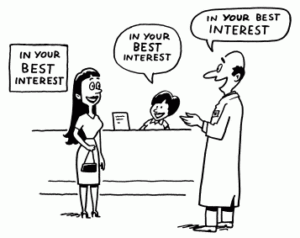
A diversified medical group suffered from a common procedure that frustrated patients, doctors and laboratory technicians every day.
First, doctors sent their patients to the laboratory for tests. After the tests, patients asked the laboratory technicians for results.
When technicians shared the test results, patients often got upset. When patients got upset, doctors got upset. Doctors preferred to explain test results to their patients personally and offer next steps for treatment.
But if technicians did not give patients their test results immediately, patients complained that information was being withheld and claimed the laboratory technicians were unhelpful.
The situation was clearly lose-lose-lose: patients, doctors and laboratory technicians – everyone got upset. Consulting was needed to improve the customer experience.
(Does this ever happen in your organization? Do your customers ever become frustrated, angry or confused? Do your staff get upset when your customers are upset? Does your brand image suffer, too? Are there “lose-lose-lose” situations lurking in your business that could benefit from customer service consulting?)
The medical group asked for help. Customer experience consultants diagnosed it as a case of “unmanaged customer expectations.” If you were a patient, wouldn’t you want to know your test results right away?
If you were a doctor, wouldn’t you be upset if your patient knew the results before you did? If you were a technician, wouldn’t you feel caught in the middle?
This problem was solved through customer experience consulting with a simple but powerful system called “In Your Best Interest.”
Courtesy of a customer experience consulting session, the procedure has changed. When doctors order lab tests, they use a printed checklist to indicate which procedures are required. At the top of the checklist, in bold letters, is now printed this statement:
“IN YOUR BEST INTEREST, all laboratory results will be sent to your doctor who will explain them to you personally and discuss the most appropriate treatment.”
As recommended through customer experience consulting, many doctors now read this statement to their patients. Many patients read the statement themselves. Most patients understand the message, but many are so nervous about their upcoming tests, they don’t pay attention.
Another step grew out of the this session. In the waiting room of the laboratory, a large poster now hangs on the wall. In bold letters the poster repeats the message drawn up in a customer service consulting session.
All patients can see the sign, and many understand the message. But some are so anxious about their upcoming tests, they still don’t pay attention.
After the tests are done, a small percentage of patients still ask laboratory technicians for an immediate explanation of the results. For those few, the lab technicians have been trained to say the same simple sentence in a compassionate and caring manner.
By this time, everyone pays attention. Patients wait to see their doctors. Doctors can fully inform their patients. And laboratory technicians can do their job compassionately without getting caught in the middle.
That’s a “win-win-win” for everyone courtesy of customer experience consulting.
Key Learning Point For Customer Experience
Customers may become confused or frustrated by your policies and procedures. This is especially common in large organizations that may benefit from the lessons of customer experience consulting. But it’s not productive to blame your customers or your colleagues – that only makes things worse.
What is effective is to take a cue from customer experience consulting experts to resolve the situation permanently by improving the clarity and consistency of your communications.
Action Steps For Improving Customer Experience
Find a point of friction where your customers or colleagues get upset and consider how this customer experience consulting lesson might apply. Choose a tension point that has persisted for many months. Do people complain about your applications and procedures? Are your policies hard to understand? Is your guarantee confusing? Have your systems grown slowly out-of-date?
There may be good reasons why your policies and procedures were created. But the explanation may be missing today or the reason may no longer apply. In either case, you can improve the situation dramatically by paying attention to the lessons of consumer service consulting. Enhance your communications, streamline the procedure or change the policy itself.
It makes good sense to fix whatever you can, whenever you can. After all, “win-win-win” is also in your best interest to learn lessons taught by customer service consulting experts.
——————————————————————————————————————————
You may use this article in your free newsletter, website or publication providing you include this complete statement (below) with active links to the websites:
Copyright, Ron Kaufman. Used with permission. Ron Kaufman is the world’s leading educator and motivator for upgrading customer service and uplifting service culture. He is author of the bestselling “Uplifting Service” book and founder of Uplifting Service. To enjoy more customer service training and service culture articles, visit www.RonKaufman.com.
For commercial use of this article in a paid newsletter, publication, or training program, please contact us.



